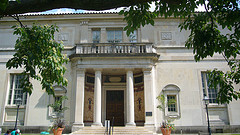Pinky says: The Barnes Museum Saga
There is this extraordinary museum in suburban Philadelphia, which has constituted one of the largest continuing controversies in the art world and has done so since its original inception in 1922. The Barnes Museum was created by Albert C. Barnes, who made his fortune by developing an early antimicrobial drug. The museum was founded and based on Barnes’ anger with the powers that ruled the social network of the city. Barnes began collecting art that many thought too contemporary for the Philadelphia Museum. Barnes then founded the Barnes Foundation as an educational art institution in suburban Lower Merion Township. The foundation holdings of more than 2500 objects include 800 paintings estimated to be worth about 25 billion dollars today. Among its collection are 181 works by Renoir, 69 by Paul Cezanne, 59 by Matisse, 46 by Picasso, and 16 by Modigliani. There are also works by Van Gogh, Gauguin, El Greco, Goya, Manet, Monet, and a variety of African artworks, ancient Egyptian works, Greek, and Roman art, and American and European decorative arts and metalwork.
Barnes not only collected all of this art; he also devised an art history concept in placing the works in “wall ensembles,” which are intentional combinations of works from different time periods, geographic areas and styles for the purpose of comparison and study. He stipulated that docents use only his particular concept of art history, which was primarily based upon his own egalitarian concept of the art world. When he died, his will stated that the collection be controlled by and benefit a black college. Barnes had risen from a blue-collar background and he firmly believed that art could equalize and educate both children and adults from the “lower classes”. The relationship with his Merion neighbors was controversial from its inception. There were constant legal battles about the huge groups of people coming in on buses, which blocked the streets and prevented the citizens of Merion from their orderly suburban life. Less than amicable settlements were reached by opening the museum collection only 2 days a week and building a parking lot for those visitors who came on the appointed days and times. There was a barely acceptable relationship between Barnes and the community of Merion.
The Foundation became embroiled in controversy again in the 1990s when a financial crisis arose due in part to the longstanding restrictions related to its location in this residential neighborhood. Funds which had been set aside for the maintenance of the foundation’s holdings were diluted by the constant lawsuits and the trust was unable to pay for repairs that were necessary to the building to maintain the property. A world tour of the collection was inaugurated in order to meet these needs. This was certainly in conflict with Barnes’ will in that he clearly stated that not a single object should ever be moved, much less than toured off the museum grounds. And when it became clear that the financial problems of the museum could only become more vexing and impossible, talk began to move the entire foundation to Philadelphia proper on the Benjamin Franklin Parkway next to the Rodin Museum and buildings owned by the Philadelphia Museum. Several more years of litigation finally met with success for the relocation to downtown Philadelphia. There has been real anger during all of this time, some of which has been recorded in a film. It is interesting that the citizens of Merion now decry the move as stripping them of their prized museum. Others in the Philadelphia community are also angered that the Barnes Foundation has maneuvered to strip Albert Barnes of his rights after his death by breaking his will in the courts.
The controversy over the move of the Barnes Foundation collection now has a new focus. A battle has emerged over the design for the museum itself. Two limestone-clad buildings are connected by an enclosed courtyard. An L shaped structure approached through gardens will house the museum’s entrance; as well as special exhibitions, a gift store, and a cafe. Meeting the foundation’s requirement, the other building’s interior layout replicates that of the original gallery, so the Albert Barnes collection can be re-installed as he arranged it. But the architects also inserted a garden courtyard, a reading room, and a classroom. Making the museum “reminiscent and transcendent at the same time” has been a struggle and that struggle has been echoed in the violent reactions to the design.
The local architecture critic says that even critics who feel that the Barnes is wrenching the collection from its historic womb will have to work to find reasons to hate this building; it is that good. While by contrast the New York Times critic finds the new building convoluted. “Almost every detail seems to ache from the strain of trying to preserve the spirit of the original building in a very different context.” A spokesperson for the Friends of the Barnes Foundation feels that it is an absurd proposition at best to recreate something that cannot be re-created, but that already exists less than 5 miles away in Merion.
Design aside, there are also concerns about the expense of the $200 million project, which includes a $50 million dollar endowment. About $44 million must still be raised. And these are not times to raise such sums easily. Robert Venturi, whose firm renovated the Merion gallery in the mid 90’s, said the design was fine but considers the project a “ridiculous waste of money.” Since the new museum’s entrance does not face the parkway, another voice gives the design an A in aesthetics and an F in urbanism.
Barnes officials are enthusiastic about the design; they feel that the new building is a marvelous way of sustaining the mission. “It is a very thoughtful response to creating a sense of cloister like calm in the middle of a busy city.” Perhaps locating in the city will strengthen the original purpose of Alfred Barnes in that all of the citizens, poor and rich alike, will have access to the collection. The building is scheduled to open in 2012. Until that time the angers and opinions will continue to boil and erupt. That has been the way the Barnes was created and the way it has survived for the last 85 years; perhaps such controversy and emotion are simply part and parcel of Alfred Barnes’ legacy and his museum.



Leave a Reply